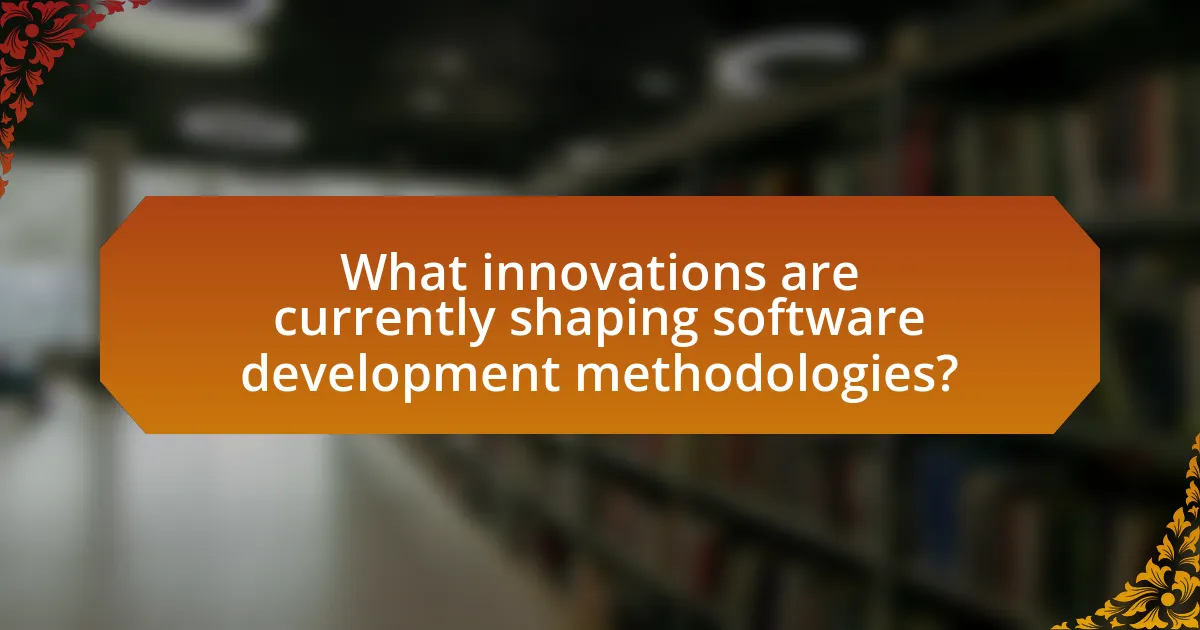The article focuses on the future of software development methodologies, highlighting emerging trends such as the adoption of DevOps, Agile practices, and low-code/no-code platforms. It examines the evolution of Agile methodologies, the integration of artificial intelligence, and the introduction of new frameworks like Scrum@Scale and SAFe. Additionally, the article discusses the impact of remote work on collaboration, the significance of user-centered design, and the role of innovations like microservices and containerization in enhancing software development practices. Key challenges and necessary skills for developers in this rapidly changing landscape are also addressed, providing a comprehensive overview of the anticipated changes and innovations shaping the field.

What are the emerging trends in software development methodologies?
Emerging trends in software development methodologies include the adoption of DevOps, Agile practices, and low-code/no-code platforms. DevOps integrates development and operations to enhance collaboration and efficiency, leading to faster delivery cycles and improved software quality. Agile methodologies, characterized by iterative development and customer collaboration, continue to evolve with frameworks like Scrum and Kanban gaining traction. Additionally, low-code/no-code platforms empower non-technical users to create applications, accelerating development processes and reducing reliance on traditional coding skills. These trends reflect a shift towards greater flexibility, collaboration, and accessibility in software development.
How are agile practices evolving in the future?
Agile practices are evolving towards greater integration of artificial intelligence and automation, enhancing efficiency and decision-making. As organizations increasingly adopt AI tools, they streamline processes such as backlog prioritization and sprint planning, allowing teams to focus on higher-value tasks. Research from McKinsey indicates that companies leveraging AI in their agile frameworks can achieve up to a 30% increase in productivity. Additionally, the rise of remote work is prompting agile methodologies to adapt by incorporating more asynchronous communication tools, which facilitate collaboration across distributed teams. This evolution reflects a broader trend of agility becoming more data-driven and responsive to real-time feedback, ensuring that agile practices remain relevant in a rapidly changing technological landscape.
What new frameworks are being introduced within agile methodologies?
New frameworks being introduced within agile methodologies include Scrum@Scale, Nexus, and SAFe (Scaled Agile Framework). Scrum@Scale extends Scrum principles to larger teams and organizations, allowing for multiple Scrum teams to coordinate effectively. Nexus integrates multiple Scrum teams working on a single product, focusing on minimizing dependencies and enhancing collaboration. SAFe provides a structured approach to scale agile practices across the enterprise, incorporating principles from Lean and Agile to improve productivity and quality. These frameworks are gaining traction as organizations seek to enhance agility and collaboration in complex environments.
How does the integration of AI impact agile practices?
The integration of AI significantly enhances agile practices by automating repetitive tasks and providing data-driven insights for decision-making. AI tools can streamline project management, enabling teams to focus on high-value activities such as innovation and collaboration. For instance, AI-driven analytics can predict project risks and optimize resource allocation, leading to improved efficiency and faster delivery times. Research from McKinsey & Company indicates that organizations leveraging AI in their agile processes can achieve up to 30% faster project completion rates, demonstrating the tangible benefits of AI integration in agile methodologies.
What role does DevOps play in the future of software development?
DevOps will play a critical role in the future of software development by fostering collaboration between development and operations teams, which enhances efficiency and accelerates delivery. This integration allows for continuous integration and continuous deployment (CI/CD) practices, enabling organizations to release software updates more frequently and reliably. According to the 2021 State of DevOps Report, high-performing DevOps teams deploy 200 times more frequently than their lower-performing counterparts, with 24 times faster recovery from failures. This data underscores the importance of DevOps in achieving agility and resilience in software development, making it essential for organizations aiming to remain competitive in a rapidly evolving technological landscape.
How can DevOps practices enhance collaboration between teams?
DevOps practices enhance collaboration between teams by fostering a culture of shared responsibility and continuous communication. This integration of development and operations teams encourages transparency, as both groups work towards common goals, leading to faster feedback loops and improved problem-solving. For instance, a study by the DevOps Research and Assessment (DORA) found that organizations implementing DevOps practices experience 46 times more frequent code deployments and 96 times faster mean time to recovery, demonstrating the effectiveness of collaboration in achieving operational efficiency.
What innovations are being made in continuous integration and delivery?
Innovations in continuous integration and delivery (CI/CD) include the adoption of AI-driven automation, enhanced security integration, and the use of microservices architecture. AI-driven automation streamlines testing and deployment processes, significantly reducing time and human error. Enhanced security integration, often referred to as DevSecOps, incorporates security measures early in the development cycle, ensuring vulnerabilities are addressed proactively. The microservices architecture allows for independent deployment of services, facilitating faster updates and scalability. These innovations are supported by industry trends, such as the increasing use of cloud-native technologies and containerization, which further optimize CI/CD pipelines.
How is the shift towards remote work influencing software development methodologies?
The shift towards remote work is significantly influencing software development methodologies by accelerating the adoption of Agile practices and enhancing collaboration tools. Agile methodologies, which emphasize iterative development and flexibility, are increasingly favored in remote settings as they allow teams to adapt quickly to changing requirements and maintain productivity despite geographical barriers. Additionally, the rise of remote work has led to the proliferation of collaboration tools such as Slack, Zoom, and Jira, which facilitate real-time communication and project management, thereby improving team cohesion and workflow efficiency. According to a 2021 report by McKinsey, 70% of organizations have accelerated their digital transformation efforts, which includes adopting Agile methodologies to better support remote teams. This trend indicates a fundamental shift in how software development is approached, prioritizing adaptability and communication in a distributed work environment.
What tools are essential for remote software development teams?
Essential tools for remote software development teams include version control systems, project management software, communication platforms, and integrated development environments (IDEs). Version control systems like Git enable teams to collaborate on code efficiently, allowing for tracking changes and managing code versions. Project management software such as Jira or Trello helps teams organize tasks, set deadlines, and monitor progress, which is crucial for maintaining productivity in a remote setting. Communication platforms like Slack or Microsoft Teams facilitate real-time discussions and file sharing, ensuring that team members stay connected. Lastly, IDEs like Visual Studio Code or IntelliJ IDEA provide a robust environment for coding, debugging, and testing, which is essential for software development. These tools collectively enhance collaboration, streamline workflows, and improve overall efficiency for remote teams.
How do remote work dynamics affect team communication and productivity?
Remote work dynamics significantly impact team communication and productivity by altering interaction patterns and collaboration methods. In remote settings, teams often rely on digital communication tools, which can lead to both enhanced flexibility and potential miscommunication due to the lack of face-to-face interaction. Research indicates that remote teams may experience a 20-25% decrease in productivity due to challenges in maintaining effective communication and collaboration (Harvard Business Review, “The Remote Work Revolution,” by Tsedal Neeley). Additionally, remote work can foster a sense of isolation among team members, which may negatively affect morale and engagement, further influencing overall productivity.

What predictions do experts have for the future of software development methodologies?
Experts predict that the future of software development methodologies will increasingly focus on automation, collaboration, and adaptability. Automation tools, such as AI-driven coding assistants, are expected to streamline repetitive tasks, allowing developers to concentrate on more complex problem-solving. Collaboration will be enhanced through integrated development environments that support real-time teamwork, reflecting the growing trend of remote work. Additionally, methodologies will evolve to be more adaptable, incorporating agile principles that allow teams to respond quickly to changing requirements and market conditions. This prediction is supported by the rise of DevOps practices, which emphasize continuous integration and delivery, as well as the increasing adoption of microservices architecture, enabling more flexible and scalable software solutions.
What are the anticipated changes in project management approaches?
Anticipated changes in project management approaches include a shift towards more agile methodologies, increased integration of artificial intelligence, and a greater emphasis on remote collaboration tools. Agile methodologies, which prioritize flexibility and iterative progress, are expected to become more prevalent as organizations seek to adapt quickly to changing market demands. The integration of artificial intelligence will enhance decision-making processes and automate routine tasks, thereby increasing efficiency. Additionally, the rise of remote work has led to a focus on tools that facilitate collaboration across distributed teams, making communication and project tracking more effective. These trends are supported by industry reports indicating that 71% of organizations are adopting agile practices to improve project outcomes and that AI-driven project management tools are projected to grow significantly in usage by 2025.
How will hybrid methodologies shape future projects?
Hybrid methodologies will shape future projects by integrating the strengths of both traditional and agile approaches, leading to increased flexibility and efficiency. This integration allows teams to adapt to changing requirements while maintaining structured planning, which is essential in complex project environments. Research indicates that organizations employing hybrid methodologies report a 30% improvement in project delivery times and a 25% increase in stakeholder satisfaction, demonstrating their effectiveness in balancing predictability with adaptability.
What is the expected impact of low-code/no-code platforms?
Low-code/no-code platforms are expected to significantly democratize software development by enabling non-technical users to create applications without extensive programming knowledge. This shift is projected to accelerate the development process, allowing businesses to respond more quickly to market demands and reduce reliance on traditional IT resources. According to a report by Gartner, by 2024, low-code application development will account for more than 65% of all application development activity, highlighting the growing trend towards these platforms. This democratization not only enhances productivity but also fosters innovation, as more individuals can contribute to the development process, leading to a wider variety of solutions and applications.
How will emerging technologies influence software development practices?
Emerging technologies will significantly influence software development practices by enhancing automation, improving collaboration, and enabling more efficient workflows. For instance, the integration of artificial intelligence (AI) in coding can automate repetitive tasks, allowing developers to focus on more complex problem-solving. According to a report by McKinsey, AI can increase productivity in software development by up to 40% by streamlining processes and reducing errors. Additionally, technologies like cloud computing facilitate real-time collaboration among distributed teams, which is essential for agile methodologies. The adoption of DevOps practices, supported by emerging tools, further accelerates the software delivery lifecycle, leading to faster deployment and improved quality.
What role will machine learning play in software development?
Machine learning will significantly enhance software development by automating tasks, improving code quality, and enabling predictive analytics. By leveraging algorithms that learn from data, developers can automate repetitive coding tasks, such as bug detection and code reviews, which increases efficiency and reduces human error. For instance, tools like GitHub Copilot utilize machine learning to suggest code snippets based on context, streamlining the coding process. Additionally, machine learning can analyze historical project data to predict project timelines and resource needs, allowing for better project management and planning. This integration of machine learning into software development processes is supported by industry trends, as a report from McKinsey indicates that organizations adopting AI technologies have seen productivity increases of 20-30%.
How can blockchain technology transform software methodologies?
Blockchain technology can transform software methodologies by enhancing transparency, security, and collaboration in the development process. By utilizing decentralized ledgers, teams can ensure that all changes to code are recorded immutably, reducing the risk of fraud and errors. This transparency fosters trust among team members and stakeholders, as everyone has access to the same information in real-time. Additionally, smart contracts can automate various aspects of software development, such as testing and deployment, streamlining workflows and reducing manual intervention. Research indicates that companies adopting blockchain in their software development processes have reported increased efficiency and reduced costs, demonstrating its potential to revolutionize traditional methodologies.
What are the potential challenges facing future software development methodologies?
Future software development methodologies face several potential challenges, including rapid technological changes, integration of artificial intelligence, and the need for enhanced collaboration among distributed teams. Rapid technological changes can lead to methodologies becoming obsolete quickly, as new tools and frameworks emerge, requiring constant adaptation. The integration of artificial intelligence introduces complexities in decision-making processes and necessitates new skills for developers, which can create a skills gap. Additionally, as teams become more distributed, maintaining effective communication and collaboration becomes increasingly difficult, potentially impacting project timelines and quality. These challenges highlight the need for methodologies that are flexible, adaptive, and focused on continuous learning to remain effective in a fast-evolving landscape.
How can teams prepare for the rapid pace of technological change?
Teams can prepare for the rapid pace of technological change by adopting agile methodologies that emphasize flexibility and continuous learning. Agile practices, such as iterative development and regular feedback loops, enable teams to quickly adapt to new technologies and market demands. Research indicates that organizations implementing agile frameworks experience a 20-30% increase in productivity and a 50% reduction in time to market, demonstrating the effectiveness of this approach in responding to technological advancements. Additionally, fostering a culture of innovation and encouraging ongoing training ensures that team members remain proficient in emerging technologies, further enhancing their ability to navigate change effectively.
What skills will be essential for software developers in the future?
Essential skills for software developers in the future will include proficiency in artificial intelligence and machine learning, cloud computing, and cybersecurity. As technology evolves, developers must adapt to integrate AI and machine learning into applications, which is evidenced by the increasing demand for AI-related skills in job postings, reflecting a 74% growth in AI job listings from 2015 to 2020. Additionally, expertise in cloud computing is crucial, as organizations increasingly rely on cloud services for scalability and flexibility, with the global cloud computing market projected to reach $832.1 billion by 2025. Cybersecurity skills are also vital, given the rising number of cyber threats; a report from Cybersecurity Ventures predicts that cybercrime will cost the world $10.5 trillion annually by 2025. These skills will enable developers to create innovative, secure, and efficient software solutions in a rapidly changing technological landscape.

What innovations are currently shaping software development methodologies?
Innovations currently shaping software development methodologies include DevOps practices, Agile frameworks, and the integration of artificial intelligence. DevOps enhances collaboration between development and operations teams, leading to faster delivery and improved quality. Agile methodologies, such as Scrum and Kanban, promote iterative development and flexibility, allowing teams to adapt to changing requirements efficiently. The integration of artificial intelligence facilitates automation in testing, code reviews, and project management, significantly increasing productivity. According to the 2023 State of DevOps Report, organizations implementing DevOps practices experience 46 times more frequent code deployments, highlighting the effectiveness of these innovations in transforming software development.
How are microservices architecture changing software development?
Microservices architecture is transforming software development by enabling greater scalability, flexibility, and faster deployment cycles. This architectural style allows developers to build applications as a collection of loosely coupled services, which can be developed, deployed, and scaled independently. According to a 2021 report by the Cloud Native Computing Foundation, 92% of organizations are adopting microservices to improve their software delivery speed and efficiency. This shift facilitates continuous integration and continuous deployment (CI/CD) practices, allowing teams to release updates more frequently and respond to market changes swiftly.
What advantages do microservices offer over traditional monolithic architectures?
Microservices offer several advantages over traditional monolithic architectures, primarily in scalability, flexibility, and resilience. In a microservices architecture, individual services can be developed, deployed, and scaled independently, allowing organizations to respond quickly to changing business needs and user demands. This independence enhances the ability to adopt new technologies and frameworks without overhauling the entire system.
Additionally, microservices improve fault isolation; if one service fails, it does not necessarily bring down the entire application, which is a common risk in monolithic systems. According to a study by the National Institute of Standards and Technology, systems designed with microservices can achieve up to 30% faster deployment times compared to monolithic architectures, demonstrating their efficiency in software development.
How does containerization enhance microservices deployment?
Containerization enhances microservices deployment by providing isolated environments for each microservice, which improves scalability and consistency. This isolation allows developers to package applications with their dependencies, ensuring that they run uniformly across different computing environments. According to a study by Gartner, organizations that adopt containerization can achieve up to 50% faster deployment times, as containers streamline the development and deployment processes. Additionally, container orchestration tools like Kubernetes facilitate automated scaling and management of microservices, further optimizing resource utilization and operational efficiency.
What is the significance of user-centered design in future methodologies?
User-centered design is significant in future methodologies as it prioritizes the needs and experiences of users, leading to more effective and satisfying products. By focusing on user feedback and iterative testing, methodologies can adapt to real-world usage, enhancing usability and engagement. Research indicates that organizations employing user-centered design principles see a 50% reduction in development costs and a 60% increase in user satisfaction, demonstrating its impact on both efficiency and product quality.
How can user feedback be effectively integrated into development cycles?
User feedback can be effectively integrated into development cycles by employing iterative development practices, such as Agile methodologies, which prioritize regular feedback loops. Agile frameworks, like Scrum, facilitate continuous user involvement through sprints and reviews, allowing teams to adapt based on user insights. Research indicates that organizations utilizing Agile report a 37% increase in project success rates, as they can quickly respond to user needs and preferences. This integration of user feedback not only enhances product relevance but also fosters user satisfaction and loyalty, ultimately leading to better market performance.
What tools support user-centered design in software development?
User-centered design in software development is supported by tools such as Sketch, Adobe XD, Figma, and InVision. These tools facilitate the creation of user interfaces and prototypes, enabling designers to focus on user needs and experiences. For instance, Figma allows real-time collaboration, which enhances feedback from users and stakeholders, while Adobe XD provides features for wireframing and interactive prototypes. Research indicates that using these tools can significantly improve user satisfaction and usability metrics, as they allow for iterative testing and refinement based on user feedback.
What best practices should teams adopt for successful software development?
Teams should adopt Agile methodologies for successful software development. Agile promotes iterative development, allowing teams to respond quickly to changes and deliver incremental improvements. Research by the Standish Group indicates that Agile projects have a 28% higher success rate compared to traditional methodologies, highlighting its effectiveness in enhancing project outcomes. Additionally, incorporating continuous integration and continuous deployment (CI/CD) practices enables teams to automate testing and deployment, reducing errors and accelerating delivery. A study by DORA (DevOps Research and Assessment) found that high-performing teams that implement CI/CD practices can deploy code 200 times more frequently than their low-performing counterparts, further validating the importance of these best practices.
How can teams ensure effective communication and collaboration?
Teams can ensure effective communication and collaboration by implementing structured communication channels and utilizing collaborative tools. Structured communication channels, such as regular stand-up meetings and defined reporting lines, facilitate clarity and accountability among team members. Collaborative tools like project management software and instant messaging platforms enhance real-time information sharing and task tracking, which are essential for maintaining alignment on project goals. Research indicates that teams using collaborative tools experience a 20-30% increase in productivity, demonstrating the effectiveness of these strategies in fostering communication and collaboration.
What strategies can be implemented to maintain code quality and efficiency?
To maintain code quality and efficiency, implementing automated testing and continuous integration practices is essential. Automated testing ensures that code changes do not introduce new bugs, while continuous integration allows for frequent code updates and immediate feedback on code quality. According to a study by the National Institute of Standards and Technology, organizations that adopt automated testing can reduce their defect rates by up to 40%, demonstrating a clear link between these strategies and improved code quality. Additionally, code reviews and pair programming foster collaboration and knowledge sharing, further enhancing code quality and efficiency.

